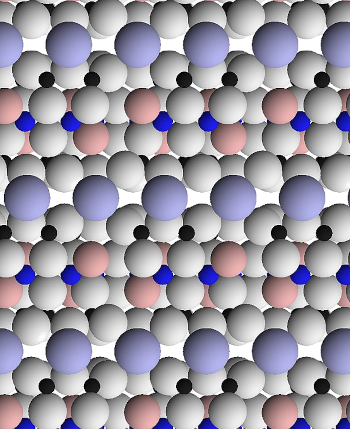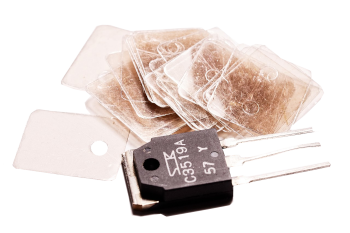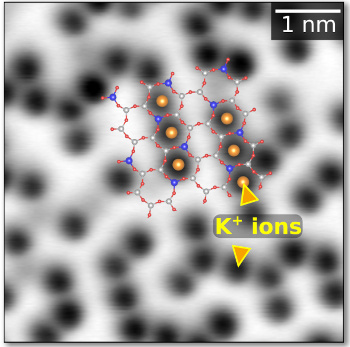Mica
February 5, 2024
Micas are a group of
phyllosilicate minerals with perfect
basal cleavage. This allows their being easily split into very thin
elastic sheets. The most common mica is
Muscovite, also known as eisenglass ("
iron glass"). The
lyrics of
The Surrey with the Fringe on Top, a
song from the 1943
musical,
Oklahoma! by
Richard Rodgers (1902-1979) and
Oscar Hammerstein (1895-1960), mentions an
isinglass curtain; but the
material would have been mica.

This atomic representation of Muscovite mica shows a view parallel to its layers. Two full layers are seen at the image center.
Muscovite has the general formula (KF)2(Al2O3)3(SiO2)6(H2O).
Oxygen anions are white, fluoride anions are light pink, tetrahedral silicon or aluminum cations are black, octahedral aluminum cations are dark blue, and potassium cations are light blue. The layers are bound together by potassium cations.
(Wikimedia Commons image by Kent G. Budge. Click for larger image.)
Mica was a common
electronic material in the early
20th century because of its availability as large
sheets, often many
square meters in
area, that could be
cut,
die-
stamped, and
machined to close
tolerance. Mica was used as the
dielectric material in
stable,
high-Q silver mica capacitors in
radio transmitters and
radio receivers. Mica sheets also provided support for
heating wires up to 900
°C (1,650
°F) in
heat guns and other heating devices.

A common application for mica in late 20th century electronics.
These thin sheets provided good thermal conductivity for heat transfer from a power transistor to a heat sink with electrical insulation.
Wikimedia Commons
As I've stated in many previous
articles,
science advances more from the development of improved
instrumentation than through
theory. The most recently developed instruments for
surface studies, the
scanning tunneling microscope (1981) and the
atomic force microscope (1985), were developed by the
talented engineers and
physicists,
Gerd Binnig (b. 1947),
Heinrich Rohrer (1933-2013),
Calvin Quate (1923-2019), and
Christoph Gerber (b. 1942). A
research team from the
Vienna University of Technology (TU Wien, Vienna, Austria) and
Charles University (Prague, Czech Republic) has used atomic force microscopy (AFM) to determine the distribution of K
+ cations at
low temperatures on
cleaved mica under ultra-high vacuum.[1-2] Their research is described in an open access article in Nature Communications.[1]
Surfaces of atomically thin materials, such as
graphene and
molybdenum disulfide, are a popular research area in
solid state physics since they have properties that are different from their
bulk materials.[2] Mica has been an object of study in many diverse fields, including
biochemistry,
geochemistry,
nanotribology, and electronics.[1] However, the surface structure of mica has not been studied on an atomic scale.[2] The mica crystal structure allows for incorporation of many
elements, and Muscovite mica has a layered structure of alternating
aluminosilicate and K
+ layers.[1] Muscovite splits apart at the K
+ layers, and there are an equal number of such cations on each created surface so that
charge neutrality can be maintained.[1]
The present study is an attempt to find whether K
+ cations are distributed
randomly on the surface, ow whether they were
ordered.[1] The mica surface, as are all surfaces, is difficult to examine, since atoms and
molecules from the
environment are easily
adsorbed. The Vienna University of Technology is
fortunate in having developed an atomic force microscope that images materials in an
ultra-high vacuum.[2] Says
post-doctoral researcher and first
author of the paper,
Giada Franceschi,
"We were able to see how the potassium ions are distributed on the surface... We were also able to gain insights into the positions of the aluminum ions under the surface layer - this is a particularly difficult task experimentally."[2]

Not so random.
The study shows that the K+ cations on the surface, imaged as black, are arranged with short-range order.
The images were acquired using a stiff AFM cantilever that is less affected by the highly-charged surface of mica that will reduce atomic contrast.
The K+ cations sit on an hexagonal lattice of lattice constant 0.52 nm and occupy approximately half of the surface sites.[1]
(Vienna University of Technology image. Click for larger image.)
The AFM images showed that the K
+ cations are not randomly distributed on the surface, but are grouped into small
assemblages (see figure), a condition of short-range order.[1-2] The possibility of this order was confirmed by
density functional theory (DFT) calculations and
Monte Carlo simulations that reveal the importance of the subsurface Al
3+ cations to the surface K
+ cation arrangement.[1] This reveals a potential problem in the use of mica as an insulating
substrate for graphene electronics.[2]
References:
- Giada Franceschi, Pavel Kocán, Andrea Conti, Sebastian Brandstetter, Jan Balajka, Igor Sokolović, Markus Valtiner, Florian Mittendorfer, Michael Schmid, Martin Setvín, and Ulrike Diebold, "Resolving the intrinsic short-range ordering of K+ ions on cleaved muscovite mica," Nature Communications, vol. 14, no. 1 (January 13, 2023), Article no. 208, https://doi.org/10.1038/s41467-023-35872-y. This is an open access article with a PDF file here.
- The Last Mysteries of Mica, Vienna University of Technology Press Release, January 25, 2023.
Linked Keywords: Mica; phyllosilicate; mineral; cleavage (crystal); basal cleavage; elasticity (physics); elastic; lamella (materials); sheet; Muscovite; iron; glass; lyrics; The Surrey with the Fringe on Top; song; musical theater; musical; Oklahoma!; Richard Rodgers (1902-1979); Oscar Hammerstein (1895-1960); isinglass; light curtain; material; Muscovite layers at the atomic scale; atom; atomic; Muscovite; parallel (geometry); lattice plane; layer; empirical formula; potassium; fluoride; aluminum; oxygen; silicon; hydrogen; anion; tetrahedral symmetry; cation; octahedron; octahedral; Muscovite structure; Kent G. Budge; electronic; 20th century; square meter; area; cutting; cut; die (manufacturing); stamping (metalworking); stamped; machining; machined; engineering tolerance; dielectric; chemical stability; stable; Q factor; high-Q; silver mica capacitor; radio transmitters; radio receiver; Joule heating; heating wires; Celsius; °C; Fahrenheit; °F; heat gun; 20th century; thermal conductivity; heat transfer; power transistor; heat sink; electrical insulation; Wikimedia Commons; blog; article; science; scientific instrument; instrumentation; scientific theory; surface science; surface studies; scanning tunneling microscope; atomic force microscope; aptitude; talented; electrical engineering; engineer; physicist; Gerd Binnig (b. 1947); Heinrich Rohrer (1933-2013); Calvin Quate (1923-2019); Christoph Gerber (b. 1942); research; TU Wien; Vienna University of Technology (TU Wien, Vienna, Austria); Charles University (Prague, Czech Republic); cryogenics; low temperature; cleavage (crystal); cleave; graphene; molybdenum disulfide; solid state physics; crystal; bulk material; biochemistry; geochemistry; tribology; nanotribology; chemical element; aluminosilicate; charge conservation; charge neutrality; randomness; random; order and disorder (physics); ordered; molecule; environment (biophysical); adsorption; adsorbed; fortunate; ultra-high vacuum; post-doctoral researcher; author; Giada Franceschi; K+; surface; stiffness; stiff; AFM cantilever; electric charge; highly-charged; contrast ratio; hexagonal crystal family; hexagonal lattice; lattice constant; nanometer; nm; assemblage; density functional theory (DFT); computer simulation; calculation; Monte Carlo method; Monte Carlo simulation; substrate (electronics).